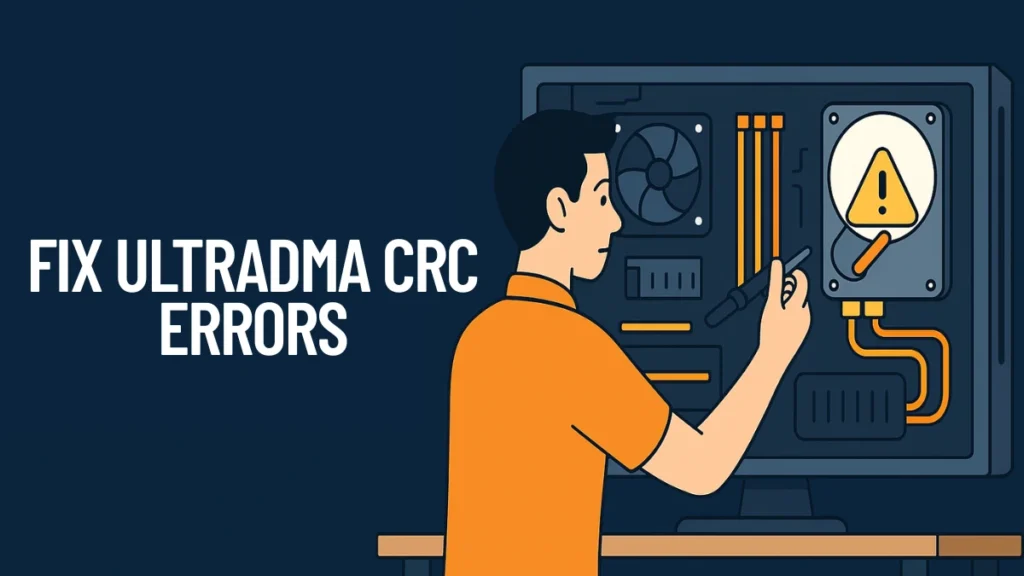UltraDMA CRC (Cyclic Redundancy Check) errors are a common issue affecting hard drives and SSDs using the Ultra Direct Memory Access (UDMA) protocol. These errors signal data transmission problems between the storage device and the system often due to cable or port issues—not necessarily a failing drive.

This guide covers what UltraDMA CRC errors are, why they happen, how to fix them, and how to prevent them.
What Are UltraDMA CRC Errors?
UltraDMA (Ultra Direct Memory Access) is a high-speed data transfer protocol used in ATA and SATA drives. It allows direct memory access with minimal CPU intervention, improving system efficiency.
A CRC error occurs when a checksum mismatch is detected during data transfer. This indicates that data became corrupted between the drive and the system’s SATA controller.
How Are CRC Errors Tracked?
- Monitored by SMART attribute 199 (UDMA_CRC_Error_Count).
- This count is non-resettable—it logs every CRC error ever recorded.
- A small number of errors (e.g., 1–10) isn’t unusual, but a growing count signals a problem that needs attention.
Tools to Check This:
- CrystalDiskInfo (Windows)
- smartctl via
smartmontools(Linux/macOS) - GSmartControl
- Hard Disk Sentinel
Look for SMART attribute 199. The raw value shows how many CRC errors occurred.
How to Fix UltraDMA CRC Errors
Fixing UltraDMA CRC errors involves a systematic approach—starting with the simplest physical checks and working your way toward more advanced diagnostics. Since these errors are typically caused by communication issues between your drive and motherboard, addressing cabling, power supply stability, driver compatibility, and hardware reliability will usually resolve them.
Below is a step-by-step breakdown to help you eliminate the root cause and restore data integrity.
Step 1: Check Physical Connections
- Reseat the SATA cable on both drive and motherboard ends
- Replace with a new, shielded SATA 3.0 cable
- Try another SATA port
- Avoid tight bends or bundled cables
Step 2: Update or Reinstall Drivers
To ensure smooth communication between your system and storage devices, keeping drivers current is key.
- Open Device Manager (
Win + X> Device Manager) - Expand Disk Drives, right-click the drive
- Choose Update Driver or Uninstall Device and restart
Step 3: Run Disk Checks
Running a disk check helps verify the drive’s internal health and file system integrity.
- Use
chkdskfrom Command Prompt:
chkdsk /f X: (Replace X with your drive letter)- Run manufacturer tools like:
- SeaTools (Seagate)
- WD Data Lifeguard (Western Digital)
Step 4: Check Power Supply
CRC errors can be triggered by inconsistent power delivery. Make sure the drive is receiving stable power.
- Test with another PSU if possible
- Avoid chaining multiple drives on one cable
- Replace faulty splitters or connectors
Step 5: Update BIOS/UEFI
Outdated firmware can lead to compatibility problems with newer drives or settings.
- Visit your motherboard manufacturer’s website
- Download the latest BIOS file and follow flashing instructions
Step 6: Try Drive in Another System
If all else fails, isolating the drive by connecting it to a different system can confirm if the issue is local to your PC.
- Connect your drive to another PC or external enclosure
- If errors stop, your system’s motherboard is likely the issue
Step 7: Advanced Fixes
For persistent or hard-to-isolate issues, consider these solutions:
- Use a PCIe SATA controller card to bypass faulty ports
- Separate SATA cables from power lines to reduce interference
When Should You Worry About CRC Errors?
| Scenario | Action |
|---|---|
| 1–2 errors, no increase | Monitor, but no immediate action needed |
| Slowly increasing count | Check cables, update drivers, and test power |
| Rapidly increasing count | Replace cables, test drive in another system |
| Drive disabled in RAID/Unraid | Immediate replacement recommended |
Preventing Future CRC Errors
- Use high-quality, shielded SATA cables
- Secure cables to avoid movement and vibration
- Avoid bending SATA cables tightly or bundling with power wires
- Keep BIOS and storage drivers updated
- Monitor SMART data regularly (e.g., once a month)
- Maintain current backups of critical data
Conclusion
UltraDMA CRC errors are usually communication issues—not signs of drive death. Most often, they’re due to poor cable quality or loose connections. By checking cables, updating drivers, testing power supply, and using diagnostics, you can fix the issue and prevent recurrence.
If the count stabilizes after these fixes, you’re in the clear. But if errors rise continuously, consider replacing the drive or inspecting your motherboard more deeply.
Got specific SMART data you’d like analyzed? Drop it in the comments for a tailored solution.
More Tech Guides
- 01How to Install Sysinternals Suite on Windows 10/11
- 02How to Fix Windows Blue Screen Error 0x000000000000010E After Hibernation
- 03Windows 11 Firewall Best Practices: 8 Ways to Secure Your PC
- 04Windows 11 Installation Has Failed Error: How to Fix Upgrade Problems
- 05How to Fix Windows 11 HYPERVISOR ERROR BSOD on Boot or Resume From Sleep
- 06Windows 11 Installation Stuck or Fails During Upgrade Process (How to Fix)
- 07Windows Upgrade Error 0x8007042B-0x2000D When Updating From 23H2 to 25H2 (How to Fix)
- 08How to Fix Windows 11 Version 25H2 Update Error 0x8007001F

